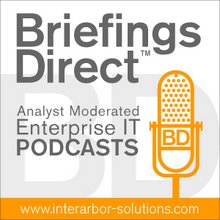Based on the Eclipse Process Framework (EPF),
 an open-source project managed by the Eclipse Foundation, the TOGAF Customizer can be used to implement TOGAF 9 more easily. TOGAF is an industry-consensus framework and method for enterprise architecture (EA) developed by The Open Group, and released in February. [Disclosure: The Open Group is a sponsor of BriefingsDirect podcasts.]
an open-source project managed by the Eclipse Foundation, the TOGAF Customizer can be used to implement TOGAF 9 more easily. TOGAF is an industry-consensus framework and method for enterprise architecture (EA) developed by The Open Group, and released in February. [Disclosure: The Open Group is a sponsor of BriefingsDirect podcasts.]The new customizer contains all the content of TOGAF 9 in a structured and editable form, including guidelines, concepts, and checklists, as well as detailed work breakdown structures for the framework’s new and improved architecture development method (ADM).
In a nutshell, moving TOGAF into an industry-standard IDE brings a Web 2.0 flavor to the document, making it akin to a wiki. What's more, collaborating via an IDE's built-in communications and sharing attributes -- as well as version management -- can make TOGAF more into a "living" document, and eases innovation and ongoing improvement.
With the new tool, users can align their EA practices with TOGAF 9 and create organization-specific versions of the standard that represent the concerns of their unique business and technology environments. All goes into and out of a common repository. In addition, the new tool makes it much easier for enterprise architects to integrate TOGAF with other common EA frameworks, such as Zachman, FEAF and DoDAF.
Key features and benefits of the TOGAF Customizer include:
- Specific constructs for tasks and steps enable processes to be formally defined with related content, such as inputs, outputs, roles and responsibilities
- Supporting editor allows users to make changes to the standard TOGAF framework content and tailor it to their specific organizational context
- Underlying content management system supports group collaboration, editing and versioning
- Plug-in architecture allows new content packages, including document templates, to be created and linked to TOGAF
Many architects are familar with the development lifecycle, and many developers have designs on becoming archiects, so the melding of two essential IT fucntions on a common pallette, so to speak, makes a great deal of sense.
I can hardly wait for what we've seen so far with Google Wave to come into prime time. Combining what Google Wave, the Eclipse IDE and TOGAF 9 does will make for a powerfully productive future.
And, of course, we should never under estimate the power of the community effect. I expect we'll see quite a bit of novel innovation from how users leverage and expand on what the framework in an IDE value only begins with.





